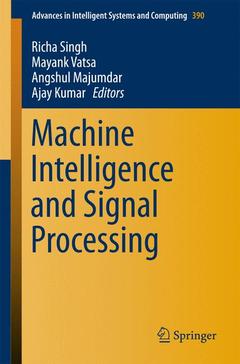Description
Machine Intelligence and Signal Processing, 1st ed. 2016
Advances in Intelligent Systems and Computing Series, Vol. 390
Language: English
Subject for Machine Intelligence and Signal Processing:
Support: Print on demand
Description
/li>Contents
/li>Biography
/li>Comment
/li>
Richa Singh received her M.S. and Ph.D. degrees in computer science in 2005 and 2008, respectively from the West Virginia University, Morgantown, USA. She is currently an Associate Professor and recipient of the Kusum and Mohandas Pai Faculty Research Fellowship at the Indraprastha Institute of Information Technology (IIIT) Delhi, India. Her research has been funded by the UIDAI and DEITY, Government of India. She is a recipient of the FAST award by DST, India. Her areas of interest are biometrics, pattern recognition, and machine learning. She has more than 150 publications in refereed journals, book chapters, and conferences. She is an editorial board member of the Journal of Information Fusion and EURASIP Journal on Image and Video Processing. She is the PC Co-Chair of International Conference on Biometrics: Theory, Applications and Systems, 2016. Dr. Singh is a member of the IEEE, Computer Society and the Association for Computing Machinery. She is a recipient of several best paper and best poster awards in international conferences.
Mayank Vatsa received the M.S. and Ph.D. degrees in computer science in 2005 and 2008, respectively from the West Virginia University, Morgantown, USA. He is currently an Associate Professor and AR Krishnaswamy Faculty Research Fellow at the Indraprastha Institute of Information Technology (IIIT) Delhi, India. He has more than 150 publications in refereed journals, book chapters, and conferences. His research has been
funded by the UIDAI and DEITY, Government of India. He is a recipient of the FAST award by DST, India. His areas of interest are biometrics, image processing, computer vision, and information fusion. Dr. Vatsa is a member of the IEEE, Computer Society and the Association for Computing Machinery. He is the recipient of several best paper and best poster awards in international conferences. He is also an associate editor of IEEE Access, area editor of Information Fusion, and IEEE BiomePresents multi-disciplinary papers in the domain of machine learning and signal processing
Contains selected tutorial style papers written by eminent researchers
Includes different applications such as biomedical signal processing, image processing, compressed sensing and biometrics
Includes supplementary material: sn.pub/extras

